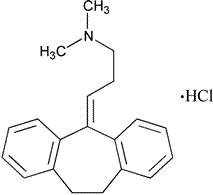Amitriptyline Hydrochloride
1-Propanamine,3-(10,11-dihydro-5H-dibenzo[a,d]cyclohepten-5-ylidene)-N,N-dimethyl-,hydrochloride.
10,11-Dihydro-N,N-dimethyl-5H-dibenzo[a,d]cycloheptene-D5,g-propylamine hydrochloride [549-18-8].
»Amitriptyline Hydrochloride contains not less than 99.0percent and not more than 100.5percent of C20H23N·HCl,calculated on the dried basis.
Packaging and storage—
Preserve in well-closed containers.
Identification—
A:
Infrared Absorption á197Kñ.
B:
Ultraviolet Absorption á197Uñ—
Solution:
10µg per mL.
Medium:
methanol.
Absorptivities at 239nm,calculated on the dried basis,do not differ by more than 3.0%.
C:
It responds to the tests for Chloride á191ñ.
pHá791ñ:
between 5.0and 6.0,in a solution (1in 100).
Loss on drying á731ñ—
Dry it at a pressure not exceeding 5mm of mercury at 60 to constant weight:it loses not more than 0.5%of its weight.
to constant weight:it loses not more than 0.5%of its weight.
Residue on ignition á281ñ:
not more than 0.1%.
Heavy metals,Method IIá231ñ:
0.001%.
Chromatographic purity—
Standard solutions—
Dissolve USP Amitriptyline Hydrochloride RSin methanol,and mix to obtain a solution having a known concentration of 0.8mg per mL.Quantitatively dilute this solution with methanol to obtain Standard solutions,designated below by letter,having the following compositions:
| Standard Preparation | Dilution | Concentration (µg RS per mL) |
Percentage (%,for comparison with test specimen) |
| A | (1in 2) | 400 | 1.0 |
| B | (1in 4) | 200 | 0.5 |
| C | (1in 5) | 160 | 0.4 |
| D | (1in 10) | 80 | 0.2 |
| E | (1in 20) | 40 | 0.1 |
Test solution—
Dissolve an accurately weighed quantity of Amitriptyline Hydrochloride in methanol to obtain a solution containing 40mg per mL.
Procedure—
Apply separately 10µLof the Test solutionand 10µLof each Standard solutionto a suitable thin-layer chromatographic plate (see Chromatography á621ñ)coated with a 0.25-mm layer of chromatographic silica gel mixture.Allow the applications to dry,position the plate in a chromatographic chamber,and develop the chromatograms in a solvent system consisting of a mixture of chloroform,methanol,and ammonium hydroxide (135:15:1)until the solvent front has moved about three-fourths of the length of the plate.Remove the plate from the developing chamber,mark the solvent front,and allow the solvent to evaporate.Examine the plate under short-wavelength UVlight.Compare the intensities of any secondary spots observed in the chromatogram of the Test solutionwith those of the principal spots in the chromatograms of the Standard solutions.[NOTE—Disregard any spots observed at the origins of the chromatograms.]No secondary spot from the chromatogram of the Test solutionis larger or more intense than the principal spot obtained from Standard solution B(0.5%),and the sum of the intensities of all secondary spots obtained from the Test solutioncorresponds to not more than 1.0%.Disregard any spot in the chromatogram of the Test solutionthat is smaller or less intense than the principal spot obtained from Standard solution E(0.1%).
Organic volatile impurities,Method Iá467ñ:
meets the requirements.
Assay—
Dissolve about 1g of Amitriptyline Hydrochloride,accurately weighed,in 30mLof glacial acetic acid,warming slightly if necessary to effect solution.Cool,add 10mLof mercuric acetate TS,then add crystal violet TS,and titrate with 0.1Nperchloric acid VSto a green endpoint.Perform a blank determination,and make any necessary correction.Each mLof 0.1Nperchloric acid is equivalent to 31.39mg of C20H23N·HCl.
Auxiliary Information—
Staff Liaison:Ravi Ravichandran,Ph.D.,Senior Scientist
Expert Committee:(PA3)Pharmaceutical Analysis 3
USP28–NF23Page 135
Pharmacopeial Forum:Volume No.29(6)Page 1844
Phone Number:1-301-816-8330
